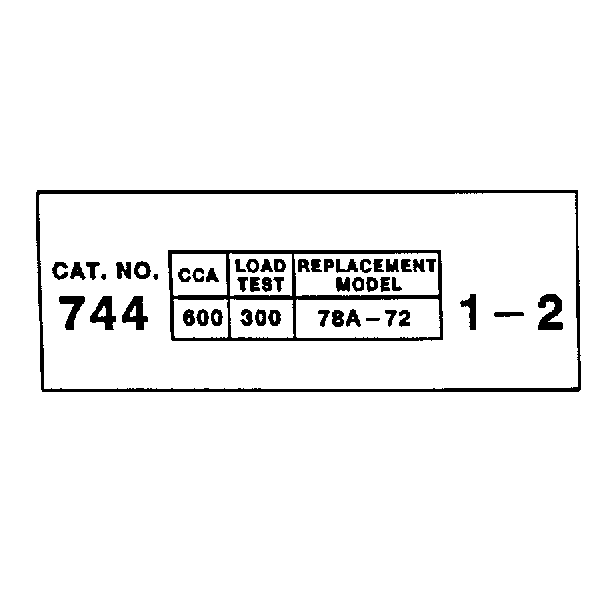General Description

The maintenance-free battery
is standard equipment in all vehicles.
These vehicles may be equipped with more than one battery, depending
on the powertrain used and optional equipment. The battery is completely sealed
except for 2 small vent holes in the sides. These vent
holes allow a small amount of gas produced in the battery to
escape.
The battery has 3 functions in the electrical system:
| • | The battery provides a source of energy for cranking the engine. |
| • | The battery acts as a voltage stabilizer for the electrical system. |
| • | The battery can, for a limited time, provide energy when the electrical
load used exceeds the output of the generator. |

The battery specification label contains information pertinent to servicing
the battery. This information includes test ratings and original equipment.
The label also includes numbers for recommended replacement
parts.
Battery Ratings
A battery has2 ratings:
Reserve Capacity
The reserve capacity is an estimate of how long the vehicle can be driven
with no generator output, the headlamps turned on, and a minimum electrical
load (most of the accessories turned off). It is the maximum amount
of time (in minutes) it will take for a fully charged battery, being
discharged at a constant rate of 25 amperes and a constant temperature
of 27°C (80°F), to reach a terminal voltage of 10.5 volts.
Other temperatures or current draws, the state of charge, or the condition
of the battery will affect how long the battery will actually last
when the vehicle is being driven without generator output.
Cold Cranking Amperage
Cold cranking amperage is an indication of the ability of the battery
to crank the engine at cold temperatures. This rating is the minimum amperage
that the battery must maintain for 30 seconds at -18°C
(0°F), while maintaining at least 7.2 volts. The actual
performance of a battery will vary with actual temperature.
Electrolyte Freezing
The freezing point of electrolyte depends on the specific gravity of
the electrolyte, or state of charge. Since freezing may ruin a battery, protect
the battery against freezing by keeping the battery charged. As long
as the green dot shows in the built-in hydrometer, the battery will
not freeze unless the temperature drops below -32°C (-25°F).
A fully charged battery will not freeze unless the temperature drops
below -54°C (-65°F).
Protection During Vehicle Storage
Some electronic devices on the vehicle impose small continuous current
drains on the battery. This is commonly called parasitic load. If the vehicle
is not used for an extended time, these parasitic loads can discharge
and eventually cause permanent damage to the battery. Discharged batteries
can also freeze in cold weather. Refer to Electrolyte Freezing.
Perform the following steps in order to help keep the battery in a charged
state while storing the vehicle:
| • | If the vehicle is likely to be stored over 30 days, inspect
the built-in hydrometer and ensure the green dot is visible. |
| | Notice: Always turn the ignition OFF when connecting or disconnecting
battery cables, battery chargers, or jumper cables. Failing to do so may damage
the Powertrain Control Module (PCM) or other electronic components.
|
| • | Disconnect the negative battery cable. This protects the battery from
being discharged by parasitic current drains from the electrical system of
the vehicle. |
| | Important: Any time the green dot in the built-in hydrometer of the battery is
not visible, promptly recharge the battery.
|
| • | If the battery cannot be disconnected, establish a regular schedule
of recharging the battery every 20-45 days in order to maintain
a high state of charge. |
| | Important: Original equipment maintenance-free batteries will not be damaged by
charge rates of 50 amps or more, as long as the battery does not spew
electrolyte from the vents or heat to over 52°C (125°F).
|
| • | In order to keep the charging time low, use a battery charger that is
capable of providing a charging voltage of at least 16 volts. |
| • | Inspect the battery being charged every 45-60 minutes.
Stop charging or reduce the charging rate as necessary. |
| • | Stop charging within 1 hour after the green dot appears
in the hydrometer in order to avoid overcharging. |
| | Important: A battery that remains in a discharged state for a long time may be
difficult to recharge. The battery may also be permanently damaged.
|
When you reconnect the battery, perform the following steps:
- Using a wire brush, lightly clean any oxidation from the contact
face of the battery terminal before reconnecting the cable.
Notice: Use the correct fastener in the correct location. Replacement fasteners
must be the correct part number for that application. Fasteners requiring
replacement or fasteners requiring the use of thread locking compound or sealant
are identified in the service procedure. Do not use paints, lubricants, or
corrosion inhibitors on fasteners or fastener joint surfaces unless specified.
These coatings affect fastener torque and joint clamping force and may damage
the fastener. Use the correct tightening sequence and specifications when
installing fasteners in order to avoid damage to parts and systems.
- Tighten the cable
bolt.
Tighten
| • | Tighten the cable bolt on a side terminal battery to 12 N·m
(106 lb in). |
| • | Tighten the cable bolt on top terminal battery to 18 N·m
(13 lb ft). |
- Reset the clock, the push-button radio tuning, and other accessories
before the vehicle is put back in service.
Built-in Hydrometer
A built-in temperature compensation hydrometer is molded into the top
of the maintenance free battery. When observing the hydrometer, ensure the
battery top is clean. Use a light in poorly-lit areas.
Under normal operating conditions, one of 3 indications can be
observed:

| • | Any green appearance
in the hydrometer is interpreted as a green dot . This means the battery is
ready for testing. |
| • | A clear or light yellow dot means the electrolyte level is below
the bottom of the hydrometer and is too low for diagnosis. When you find a
battery in this condition, this may indicate high charging voltages
caused by a faulty charging system. Because of this, the charging
and electrical systems must be inspected. Refer to
Charging System Check
. The yellow dot may have
been caused by the following conditions: |
| • | Excessive or prolonged charging |
| • | If the battery has a yellow or clear hydrometer, replace the battery
if a cranking complaint exists. |



